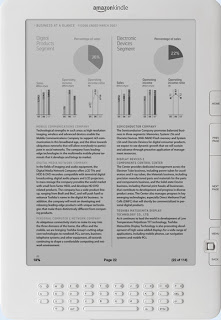
First Impressions of the New Kindle DXThe first thing I notice about the new
Kindle DX — shown Wednesday morning at a news conference in New York — is that it still seems small. That isn’t necessarily a bad thing. If it is going to replicate a newspaper or textbook, you don’t want some clunky thing to lug around.
The
Kindle DX has a 9.7-inch display, which the company says is 2 1/2 times the size of the Kindle 2. But the device doesn’t feel or look as large as a sheet of copier paper. It won’t give you the feeling of reading an entire page of a newspaper. You read the paper by flipping through it, article by article.
But you never see the big picture — a full page — that can reward you with the article you didn’t think you wanted to read, but are lured in either by the placement it on the page or the art that goes with it. The larger screen should have been able to offer a different experience than the one on the first two versions of the Kindle.
That said, the text, photos and drawings replicate the experience of reading a newspaper or a textbook.
The photographs are clearer and more defined than those you’d see on a printed page. Better than what you see on a high-resolution computer monitor? No. But if the goal was to replicate the newspaper reading experience, then Amazon seems to have succeeded.
On a biology textbook, it is very easy to see the detail to distinguish the different phalanges.
It is easy to blow the picture up, and the resolution holds as you do.
The display automatically rotates when you change the orientation of the
Kindle.
The price: $489. It ships, the company said, this summer. The Amazon.com site has it ready for pre-order. This is where many consumers may stumble. The device offers a good experience, but is it a $500 experience?
Three newspapers — The New York Times, The Washington Post and The Boston Globe — will offer a reduced price on the Kindle in exchange for a long-term subscription. The Times and Globe will be offered starting this summer in areas where home delivery is not available. No prices of that promotion were released.
Amazon emphasized that the Kindle would exchange personal documents, all without the user having to look for a wireless hot spot.
Jeff Bezos, Amazon’s chief executive, pointed out it is easier to turn the page on sheet music by pushing a button. He is right. The Kindle could find a sub-market among musicians.
Plastic Logic Vs Kindle DX – FeaturesCredit for a lot of the information in here goes to the MediaShift Blog at pbs.org.
Feature
 Every book ever in under a minute
Every book ever in under a minute
Bezos reminded the assembled journalists at this week’s launch event that the Amazon Kindle will soon be able to offer “every book ever printed, in any language, all available in less than 60 seconds.”
“Eighteen months ago, we launched Kindle, and at the time we had 90,000 books available for Kindle. (We had) 230,000 books just three months ago when we launched Kindle 2,” Bezos said. “We’ve added another 45,000 books in just the last three months. We’re actually accelerating.”
“The display is 2 and a half times the size of the Kindle 2,” added Bezos, adding that with the “Built in PDF reader, you never have to pan, you never have to zoom, you never have to scroll. You just read.”
Also, rather niftily (just as with Apple’s iPhone), “You just rotate the device and you go to widescreen mode.”
“Any highly structured documents look great on this device. Here’s a cookbook, lots of structure. Here’s another one, a photo of sushi… it’s making me hungry. Computer books, they’re highly structured, complex layouts. They shine with the
Kindle DX.”EInk screen
Kindle DX uses) say 2010 or later.
Kindle DX ebook reader started by AmazonPeople who are fond of reading books find anything and everything which comes on a piece of paper to read interesting. But in today’s busy world we don’t find enough time and place to bring those huge books along. But Amazon has a solution for all those booklovers. It is the new Kindle DX e-book reader.
With the new
Kindle DX e-book you can now read your favorite books on a 9.7 inch e-ink display. It is very clear and lucid for reading newspapers, books and other large articles. It is a user-friendly device with a built in accelerometer. With the use of the accelerometer you can easily rotate your e-book reader in any direction for more suitable reading. Kindle DX also has a PDF reader pre-installed. It can help you in opening the documents without converting them using the Amazon’s online services
The portable device is beautifully designed using the latest technology so that you will enjoy reading without paining your eyes. The
Amazon Kindle DX also supports contents from Cookbooks, computer books, and textbooks and other formats.
Featuring an in-built PDF reader, the portable device ensures resounding e-reading experiences. You don’t need to pan, zoom or scroll or re-flow the document. The all you need is emailing of your favored documents to the Kindle mail account or download the content to the portal device via an USB.
The
Kindle DX features an Auto-rotate option which enables the readers to see enhanced landscape views of pictures, graphs, maps, tables and web pages. You are ensured to flip the e-book reader to use the device in any of your hand.
As its reviews,
Kindle DX also supports 3G wireless connections. Hence, you don’t require to sit before a PC or look for WiFi hotspots to exploit Amazon’s Whispernet to access to digital contents.
With Kindle DX, you can read some of the popular newspapers like The New York Times, The Boston Globe and the Washington Post. You need to open an account to access these newspapers.
Kindle DX possesses all the important features, which we have found in its earlier version Kindle. The upgraded e-book reader offers a 250,000-word Oxford American dictionary. It also provides bookmarking option, notes and six different text sizes to make your reading experience more interesting








 New
New 






